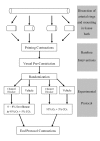Role of potassium and calcium channels in sevoflurane-mediated vasodilation in the foeto-placental circulation
- PMID: 19515255
- PMCID: PMC2702293
- DOI: 10.1186/1471-2253-9-4
Role of potassium and calcium channels in sevoflurane-mediated vasodilation in the foeto-placental circulation
Abstract
Background: Sevoflurane has been demonstrated to vasodilate the foeto-placental vasculature. We aimed to determine the contribution of modulation of potassium and calcium channel function to the vasodilatory effect of sevoflurane in isolated human chorionic plate arterial rings.
Methods: Quadruplicate ex vivo human chorionic plate arterial rings were used in all studies. Series 1 and 2 examined the role of the K+ channel in sevoflurane-mediated vasodilation. Separate experiments examined whether tetraethylammonium, which blocks large conductance calcium activated K+ (KCa++) channels (Series 1A+B) or glibenclamide, which blocks the ATP sensitive K+ (KATP) channel (Series 2), modulated sevoflurane-mediated vasodilation. Series 3 - 5 examined the role of the Ca++ channel in sevoflurane induced vasodilation. Separate experiments examined whether verapamil, which blocks the sarcolemmal voltage-operated Ca++ channel (Series 3), SK&F 96365 an inhibitor of sarcolemmal voltage-independent Ca++ channels (Series 4A+B), or ryanodine an inhibitor of the sarcoplasmic reticulum Ca++ channel (Series 5A+B), modulated sevoflurane-mediated vasodilation.
Results: Sevoflurane produced dose dependent vasodilatation of chorionic plate arterial rings in all studies. Prior blockade of the KCa++ and KATP channels augmented the vasodilator effects of sevoflurane. Furthermore, exposure of rings to sevoflurane in advance of TEA occluded the effects of TEA. Taken together, these findings suggest that sevoflurane blocks K+ channels. Blockade of the voltage-operated Ca++channels inhibited the vasodilator effects of sevoflurane. In contrast, blockade of the voltage-independent and sarcoplasmic reticulum Ca++channels did not alter sevoflurane vasodilation.
Conclusion: Sevoflurane appears to block chorionic arterial KCa++ and KATP channels. Sevoflurane also blocks voltage-operated calcium channels, and exerts a net vasodilatory effect in the in vitro foeto-placental circulation.
Figures








References
-
- Larach DR, Schuler HG. Potassium channel blockade and halothane vasodilation in conducting and resistance coronary arteries. J Pharmacol Exp Ther. 1993;267:72–81. - PubMed
LinkOut - more resources
Full Text Sources

